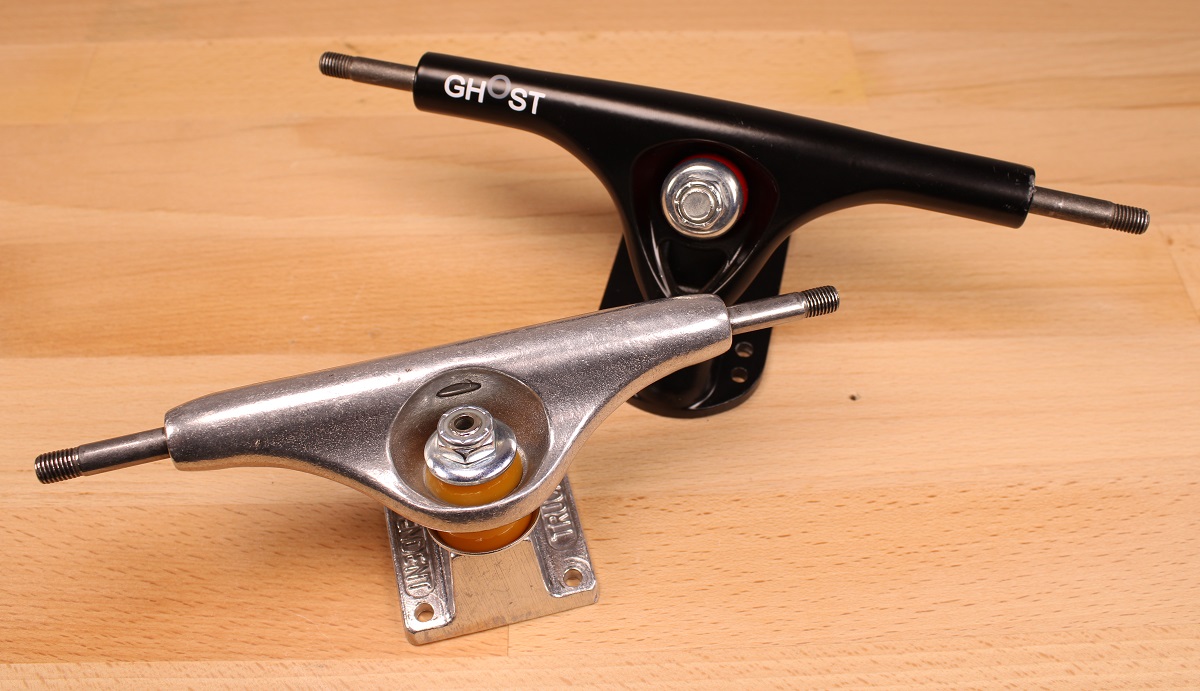We’ve covered trucks in depth, but we’ve had customers ask: What’s the difference between longboard trucks and skate trucks? After all, they look nearly identical. Can’t they be used interchangeably? Can you build a longboard using skate trucks, vice versa? Let’s review.
Longboard Trucks are Bigger

Longboards are usually wider than skateboards, so their truck axles and hangers are wider, too. Skate trucks also tend to split hairs when it comes to axle width — you’ll find dozens of skate trucks measuring between 110mm and 160mm, with options available in increments of +/- 10mm.
Longboard trucks are simpler: Most standard board shapes — like the Platypus and Pintail — use 180mm trucks (like our Ghost Trucks, shown above), while smaller deck shapes — like Wheel-Cuts, Surfers, and Surfskates — sometimes use 150mm or 165mm trucks.
Base Plates

A bigger axle and hanger also means running a bigger base plate. This is why — to answer the question — longboard trucks aren’t always compatible with skate decks.
But some longboard truck base plates are compatible with skate decks.You’ll see on our 180mm Ghost Truck base plate (above), there are six mounting holes — the two shorter holes allow this truck to be installed on a skate deck.
Axle Shafts

Virtually all longboard and skate truck axle shafts use the same shaft length, diameter, and wheel nut thread pitch. This is done to standardize the wheel hubs and bearings used on both types of boards.
When to Use Longboard Trucks on a Skate Deck
When it comes to skateboards, your truck width should closely match your deck width. Some skaters run very wide boards — up to 10″ — which would allow one to run a longboard truck. Performance-wise, this would make sense: Wide skate decks are usually ridden as cruisers and street carvers, so the high kingpin angle and reverse kingpin setup of a longboard truck would benefit this skater riding style.
Longboard vs. Skate Kingpin Angle

The angle of the truck, determined by the kingpin — the shaft that holds the bushings and hanger — is far steeper on most longboards (left). This Black Ghost Truck as a 50-degree angle, which is standard for most cruising and street-riding setups.
This steep angle is what allows longboards to carve tight at low speeds. Most skateboards have a lesser kingpin angle, closer to 90 degrees, to promote straight-line stability when setting up for vert and street tricks. This Independent Truck has a 72-degree angle.
Of course, some skateboards — like Surfskates and cruisers — may have a steeper angle, since those boards are designed for street riding and carving, like a longboard.
The high angles found on longboard kingpins necessitates that their orientation be reversed, relative to the hanger/axle. More on that next.
Reverse vs. Standard Kingpins

You can see above that the hanger on the longboard truck is oriented so its pivot point faces the tip and tail of the board, while the kingpin shaft points inward.
On skate trucks, the setup is the opposite. These typically called “standard Kingpin” (“SKP”), or “Traditional” (“TKP”). Here, the kingpin shaft points toward the tip and tail of the deck, while the hanger and its pivot point face inward. This “standard” setup reduces the overall height of the board and pivot potential of the wheels, promoting stability.
Reversed trucks raise the height of the deck further above the wheels — this is necessary given longboard wheels are far larger than skate wheels. Reversed trucks also shorten the wheelbase, promoting a tighter turning radius at low speeds.
Longboard vs. Skate Bushings

“Bigger” is the recurring theme, here: Longboard bushings are overall taller and larger, which promotes carving ability. The taller the bushing, the greater the compressive potential of the bushing, and the greater the leverage.
Longboard bushings are also typically softer — their urethane material registers lower on the Durometer A scale, with some bushings rating as soft as 78a. That’s about the same hardness rating as some longboard wheels.
Skate bushings are typically harder — they often measure closer to 100a hardness. This higher hardness rating promotes stability, and makes the deck feel “snappier” compared to a longboard deck.

